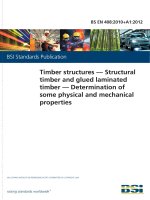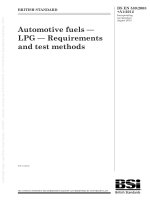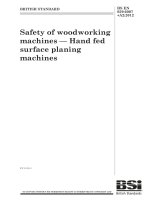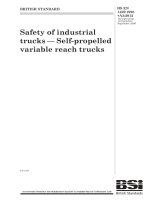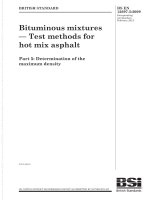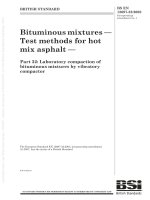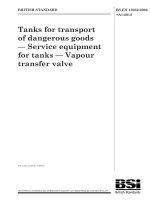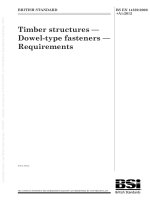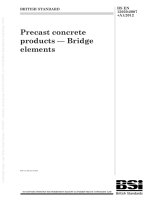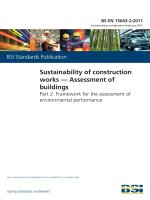Bsi bs en 62059 32 1 2012
Bạn đang xem bản rút gọn của tài liệu. Xem và tải ngay bản đầy đủ của tài liệu tại đây (1.14 MB, 19 trang )
BS EN 62059-32-1:2012
BSI Standards Publication
Electricity metering
equipment — Dependability
Part 32-1: Durability — Testing of the
stability of metrological characteristics
by applying elevated temperature
BRITISH STANDARD
BS EN 62059-32-1:2012
National foreword
This British Standard is the UK implementation of EN 62059-32-1:2012. It is
identical to IEC 62059-32-1:2011.
The UK participation in its preparation was entrusted to Technical Committee
PEL/13, Electricity Meters.
A list of organizations represented on this committee can be obtained on
request to its secretary.
This publication does not purport to include all the necessary provisions of a
contract. Users are responsible for its correct application.
© The British Standards Institution 2012
Published by BSI Standards Limited 2012
ISBN 978 0 580 66962 0
ICS 17.220; 19.020; 91.140.50
Compliance with a British Standard cannot confer immunity from
legal obligations.
This British Standard was published under the authority of the Standards
Policy and Strategy Committee on 30 April 2012.
Amendments issued since publication
Amd. No.
Date
Text affected
BS EN 62059-32-1:2012
EUROPEAN STANDARD
EN 62059-32-1
NORME EUROPÉENNE
March 2012
EUROPÄISCHE NORM
ICS 17.220; 19.020; 91.140.50
English version
Electricity metering equipment Dependability Part 32-1: Durability Testing of the stability of metrological characteristics by applying
elevated temperature
(IEC 62059-32-1:2011)
Appareils de comptage d'électricité Sûreté de fonctionnement Partie 32-1: Durabilité Contrôle de stabilité des caractéristiques
métrologiques en appliquant une
température élevée
(CEI 62059-32-1:2011)
Elektrizitätszähler Zuverlässigkeit Teil 32-1: Haltbarkeit Prüfung der Stabilität der metrologischen
Eigenschaften unter Anwendung erhöhter
Temperatur
(IEC 62059-32-1:2011)
This European Standard was approved by CENELEC on 2012-01-11. CENELEC members are bound to comply
with the CEN/CENELEC Internal Regulations which stipulate the conditions for giving this European Standard
the status of a national standard without any alteration.
Up-to-date lists and bibliographical references concerning such national standards may be obtained on
application to the CEN-CENELEC Management Centre or to any CENELEC member.
This European Standard exists in three official versions (English, French, German). A version in any other
language made by translation under the responsibility of a CENELEC member into its own language and notified
to the CEN-CENELEC Management Centre has the same status as the official versions.
CENELEC members are the national electrotechnical committees of Austria, Belgium, Bulgaria, Croatia, Cyprus,
the Czech Republic, Denmark, Estonia, Finland, France, Germany, Greece, Hungary, Iceland, Ireland, Italy,
Latvia, Lithuania, Luxembourg, Malta, the Netherlands, Norway, Poland, Portugal, Romania, Slovakia, Slovenia,
Spain, Sweden, Switzerland, Turkey and the United Kingdom.
CENELEC
European Committee for Electrotechnical Standardization
Comité Européen de Normalisation Electrotechnique
Europäisches Komitee für Elektrotechnische Normung
Management Centre: Avenue Marnix 17, B - 1000 Brussels
© 2012 CENELEC -
All rights of exploitation in any form and by any means reserved worldwide for CENELEC members.
Ref. No. EN 62059-32-1:2012 E
BS EN 62059-32-1:2012
EN 62059-32-1:2012
-2-
Foreword
The text of document 13/1483/FDIS, future edition 1 of IEC 62059-32-1, prepared by IEC/TC 13,
"Electrical energy measurement, tariff- and load control", was submitted to the IEC-CENELEC parallel
vote and approved by CENELEC as EN 62059-32-1:2012.
The following dates are fixed:
•
•
latest date by which the document has
to be implemented at national level by
publication of an identical national
standard or by endorsement
latest date by which the national
standards conflicting with the
document have to be withdrawn
(dop)
2012-10-11
(dow)
2015-01-11
Attention is drawn to the possibility that some of the elements of this document may be the subject of
patent rights. CENELEC [and/or CEN] shall not be held responsible for identifying any or all such patent
rights.
This document has been prepared under a mandate given to CENELEC by the European Commission
and the European Free Trade Association, and supports essential requirements of EU Directive(s).
For the relationship with EU Directive(s) see informative Annex ZZ, which is an integral part of this
document.
Endorsement notice
The text of the International Standard IEC 62059-32-1:2011 was approved by CENELEC as a European
Standard without any modification.
In the official version, for Bibliography, the following notes have to be added for the standards indicated:
IEC 62053-11:2003
NOTE Harmonized as EN 62053-11:2003 (not modified).
IEC 62053-22:2003
NOTE Harmonized as EN 62053-22:2003 (not modified).
IEC 62053-23:2003
NOTE Harmonized as EN 62053-23:2003 (not modified).
IEC 62055-31:2005
NOTE Harmonized as EN 62055-31:2005 ((not modified).
-3-
BS EN 62059-32-1:2012
EN 62059-32-1:2012
Annex ZA
(normative)
Normative references to international publications
with their corresponding European publications
The following documents, in whole or in part, are normatively referenced in this document and are
indispensable for its application. For dated references, only the edition cited applies. For undated
references, the latest edition of the referenced document (including any amendments) applies.
NOTE When an international publication has been modified by common modifications, indicated by (mod), the relevant EN/HD
applies.
Publication
Year
Title
EN/HD
Year
IEC 60068-2-2
2007
Environmental testing Part 2-2: Tests - Test B: Dry heat
EN 60068-2-2
2007
IEC 62052-11
2003
Electricity metering equipment (AC) - General EN 62052-11
requirements, tests and test conditions Part 11: Metering equipment
2003
IEC 62053-21
2003
Electricity metering equipment (a.c.) Particular requirements Part 21: Static meters for active energy
(classes 1 and 2)
2003
EN 62053-21
BS EN 62059-32-1:2012
EN 62059-32-1:2012
-4-
Annex ZZ
(informative)
Coverage of Essential Requirements of EU Directives
This European Standard has been prepared under the mandate M/374 given to CENELEC by the
European Commission and within its scope, this part 32-1 of EN 62059 specifies a method for
testing the stability of metrological characteristics of electricity meters, suitable for verification of
conformity with the durability requirements.
The standard covers the Essential Requirement 5, Durability, Annex I of the Directive
2004/22/EC of the European Parliament and of the council of 31 March 2004 on measuring
instruments (MID):
“A measuring instrument shall be designed to maintain an adequate stability of its metrological
characteristics over a period of time estimated by the manufacturer, provided that it is properly
installed, maintained and used according to the manufacturer's instruction when in the
environmental conditions for which it is intended.”
Compliance with this standard provides one means of conformity with the specified essential
requirements of the Directives concerned.
WARNING - Other requirements and other EU Directives may be applicable to the products
falling within the scope of this standard.
–2–
BS EN 62059-32-1:2012
62059-32-1 IEC:2011
CONTENTS
INTRODUCTION ..................................................................................................................... 5
1
Scope ............................................................................................................................... 6
2
Normative references ....................................................................................................... 6
3
Terms and definitions ....................................................................................................... 6
4
General ............................................................................................................................ 7
5
Initial measurements ........................................................................................................ 7
6
Conditioning ..................................................................................................................... 7
7
Intermediate measurements – verification of energy measurement and registration .......... 9
7.1
7.2
8
General ................................................................................................................... 9
Method A: Test method using a reference meter...................................................... 9
7.2.1 Test conditions ............................................................................................ 9
7.2.2 Test using a reference standard meter ...................................................... 10
7.2.3 Test using a reference meter of the same type as the MUT ....................... 10
7.3 Method B: Test method using a stable load ........................................................... 11
7.4 Final temperature ramp ......................................................................................... 12
Recovery ........................................................................................................................ 12
9
Final measurements and acceptance criteria .................................................................. 12
10 Information to be given in the test report ........................................................................ 13
Bibliography .......................................................................................................................... 14
Table 1 – Limits of change in percentage error at I max .......................................................... 13
BS EN 62059-32-1:2012
62059-32-1 IEC:2011
–5–
INTRODUCTION
Electricity meters are products designed for high reliability and durability to operate
continuously for extended periods without supervision.
To manage metering assets effectively, it is important to have tools for predicting and
estimating life characteristics of various types.
IEC 62059-41 provides methods for predicting the failure rate – assumed to be constant – of
metering equipment, based on the parts stress method.
IEC 62059-31-1 provides a method for estimating life characteristics using accelerated
reliability testing by operating the test specimens at elevated temperature and humidity.
Future parts of IEC 62059-31 may be established to cover accelerated reliability testing,
applying other stresses.
This standard, IEC 62059-32-1 provides a test method to evaluate one important aspect of
durability, the stability of metrology characteristics, by operating a test specimen at the upper
limit of the specified operating range of temperature, voltage and current for an extended
period. Future parts of IEC 62059-32 may be established to cover other kinds of stress or
other aspects of durability.
–6–
BS EN 62059-32-1:2012
62059-32-1 IEC:2011
ELECTRICITY METERING EQUIPMENT –
DEPENDABILITY –
Part 32-1: Durability –
Testing of the stability of metrological characteristics
by applying elevated temperature
1
Scope
The stability of metrological characteristics is one important aspect of durability.
This part of IEC 62059 specifies a method for testing the stability of metrological
characteristics of electricity meters, by operating a test specimen at the upper limit of the
specified operating range of temperature, voltage and current for an extended period.
Functional performance other than the accuracy of energy measurement is out of the scope of
this standard.
Note, that from the results of this test, no conclusion can be drawn for the length of period
during which the stability of the metrological characteristics will be maintained when the meter
is operated under usual conditions.
This International Standard is applicable to all types of electricity meters in the scope of IEC
TC 13.
2
Normative references
The following referenced documents are indispensable for the application of this document.
For dated references, only the edition cited applies. For undated references, the latest edition
of the referenced document (including any amendments) applies.
IEC 60068-2-2:2007, Environmental testing – Part 2-2: Tests – Test B: Dry heat
IEC 62052-11:2003, Electricity metering equipment (AC) – General requirements, tests and
test conditions – Part 11: Metering equipment
IEC 62053-21:2003, Electricity metering equipment (a.c.) – Particular requirements – Part 21:
Static meters for active energy (classes 1 and 2)
3
Terms and definitions
For the purposes of this document, the terms and definitions in IEC 62052-11 as well as the
following apply.
3.1
durability
the ability of an item to perform a required function under given conditions of use and
maintenance, until a limiting state is reached
NOTE A limiting state of an item may be characterized by the end of the useful life, unsuitability or any economic
or technological reasons or other relevant factors.
BS EN 62059-32-1:2012
62059-32-1 IEC:2011
–7–
[IEC 60050-191: 1990, 191-02-02]
4
General
The test procedure consists of:
•
initial measurements, see Clause 5;
•
operational conditioning at the maximum temperature, voltage and current of the specified
operating range, see Clause 6. During the conditioning, intermediate measurements are
taken, see Clause 7;
•
recovery – see Clause 8 – and final measurements, see Clause 9.
The test shall be performed on (one of) the meter(s) submitted for type testing (meter under
test, MUT).
During the conditioning, the MUT shall not exhibit any irregular behaviour concerning energy
measurement and registration. This shall be verified as specified in Clause 7.
In addition, after conditioning and recovery, the change of the percentage error, when
compared to the initial measurements, shall not exceed the limits specified in Clause 9. To
verify this, the percentage error shall be measured, as specified in Clause 5, before
conditioning and following the recovery period.
If the MUT passes the test, this gives a reasonable level of confidence that the meter type
tested is free from serious design errors and material flaws that may prevent it from
maintaining its specified accuracy for the period of use estimated by the manufacturer.
NOTE
5
For this estimation, the acceleration factor determined according to IEC 62059-31 can be used.
Initial measurements
The percentage error of the MUT shall be measured – using the test output of the MUT and
appropriate test equipment – at the following test points:
•
value of voltage: U n ;
value of current for direct connected meters: 0,1 I b , I b and I max;
value of current for transformer operated meters: 0,05 I n , I n and I max ;
•
value of power factor for meters for active energy: cos φ = 1 and cos φ = 0,5 inductive;
•
value of power factor for meters for reactive energy: sin φ = 1 and sin φ = 0,5 inductive.
•
•
The accuracy test conditions shall be as specified in the relevant type test standard.
6
Conditioning
The MUT shall be exposed to the elevated temperature according to IEC 60068-2-2 as
follows:
•
test Be: dry heat for heat-dissipating specimens with gradual change of temperature that
are required to be powered throughout the test;
•
air velocity: low preferred (see IEC 60068-2-2, 4.2);
•
temperature: the upper limit of the operating temperature range specified by the
manufacturer;
•
duration of the test: 1 000 h;
–8–
•
BS EN 62059-32-1:2012
62059-32-1 IEC:2011
MUT in operating conditions, with test load:
•
value of voltage: 1,1 U n . If the meter is intended for several reference voltages, then
the highest reference voltage shall be taken into account;
•
value of current: I max;
•
value of power factor:
•
for meters for active energy cos φ = 1;
•
for meters for reactive energy sin φ = 1;
•
if the meter measures both active and reactive energy, then the value of the power
factor shall be cos φ = 0,866 (sin φ = 0,5) inductive.
The tolerance of the voltage, current, power factor and the load that should be maintained
depends on the method chosen to verify energy measurement and registration; see 7.2 and
7.3.
The MUT shall be mounted as for normal operation, with all covers and terminal covers in
place. The ability of the MUT to transfer heat by thermal radiation shall be minimised. For
details, see IEC 60068-2-2, 6.3.
The MUT shall be connected as specified by the manufacturer, using the cable type specified
by the manufacturer. The length of the cables within the test chamber shall be 1 m each. The
cross-section shall be selected so that the current density is between 3,2 A/mm 2 and
4 A/mm 2 . If this would result in a cable with a cross-section of less than 1,5 mm 2 , then a
cable with a cross-section of 1,5 mm 2 shall be used.
In the case when the MUT is fitted with a load switch or when it is fitted with an overcurrent
tripping device or residual current device, such devices shall be disabled for this test. It shall
be confirmed that it is possible to calculate the energy consumption during the test using the
meter register.
NOTE 1
The instructions of the manufacturer should be followed.
NOTE 2 The reason for this requirement is that for example in the case of pre-payment meters, a test running for
1 000 h would require huge amounts of credit. An overcurrent load switch might trip when tested for long periods at
I max .
The MUT is introduced into the chamber, which is at the temperature of the laboratory. The
load specified above is then applied, and the meter is checked to ascertain whether it is
capable of functioning in accordance with the relevant specification.
If necessary, a test shall be performed to determine if the test facility fulfils the requirements
of a low air velocity chamber or not. See IEC 60068-2-2, 4.2.
The temperature is then adjusted to the test temperature. The rate of change of the
temperature within the test chamber shall not exceed 1 K per minute, averaged over a period
of not more than 5 min.
After temperature stability of the MUT has been reached, it is exposed to the conditions
specified above for the specified duration.
NOTE 3 Temperature stability is reached, when the variation of percentage error at I max during 20 min does not
exceed 1/5th of the limit of percentage error at reference conditions, specified in the relevant standard. This may
be determined using the test output and a reference standard meter, or by applying a stable load and measuring
the frequency of the test output pulse stream.
BS EN 62059-32-1:2012
62059-32-1 IEC:2011
7
–9–
Intermediate measurements – verification of energy measurement and
registration
7.1
General
During the conditioning, it shall be verified that the MUT does not exhibit any irregular
behaviour in energy measurement and registration.
NOTE 1 Examples of irregular behaviour are significant negative or positive measurement errors, mechanical
register jamming, LCD failure and the like.
To verify this, the percentage error of the energy registration shall be determined at the test
load, using the following formula:
percentage error =
energy registered by the meter − true energy
× 100
true energy
The energy registered by the meter during a given interval is read from the register of the
MUT.
The true energy is determined using one of the following methods:
•
Method A: using a reference meter. In this case, the true energy is read from the register
of a reference meter. For the test method and the relevant limits of percentage error, see
7.2.
•
Method B: using a stable load. In this case, the true energy is calculated by multiplying the
test load with the length of the interval between two readings. For the test method and the
relevant limits of percentage error, see 7.3.
The percentage error shall be calculated at least at the end of the test, and preferably at
regular intervals.
NOTE 2
7.2
Checking the accuracy at regular intervals facilitates an early discovery of any irregular behaviour.
Method A: Test method using a reference meter
7.2.1
Test conditions
In this case, a reference meter is installed outside the test chamber, exposed to the same
load as the MUT. The true energy is determined by reading this reference meter.
The test conditions shall be the following:
•
voltage: 1,1 U n + 2 % …- 5 %;
voltage balance (in the case of polyphase meters): ± 2 %;
•
current: I max + 2 % …- 5 %;
•
current balance (in the case of polyphase meters): ± 4 %;
•
phase displacement of each phase current from the corresponding phase-to-neutral
o
voltage irrespective of the phase angle: 4 ;
•
power factor: corresponding to ± 4 ;
•
overall tolerance of the test load: ± 5 %;
•
the laboratory temperature shall be 23 °C ± 2 °C.
•
o
NOTE As with this test method the variation of the load may cause only secondary effects, the tolerances
compared to the usual accuracy test conditions have been relaxed and do not require a high precision test bench.
BS EN 62059-32-1:2012
62059-32-1 IEC:2011
– 10 –
7.2.2
Test using a reference standard meter
In this case, a reference standard meter shall be used.
NOTE
The measurement errors of this meter should be negligible compared to the error limits of the MUT.
The limit of the percentage error, calculated using the formula in 7.1 is:
emax = 2 eo2 + eU2 + e T2
where:
•
e o is the limit of the percentage error at the test load and at the reference conditions;
•
e U is the limit of variation in percentage error due to voltage variation;
•
e T is the limit of variation in percentage error due to temperature variation,
specified in the relevant type test standard.
If the meter is for active and reactive energy, then the test, as specified in Clause 6, shall be
performed at cos φ = 0,866 (sin φ = 0,5) inductive. For the values of e o , e U and e T , the values
relevant for cos φ = 0,5 and sin φ = 0,5 shall be taken into account.
If the percentage error exceeds e max, this indicates that the behaviour of the MUT is irregular.
The MUT failed and the test can be terminated.
EXAMPLE
–
the MUT is a static meter for active energy, of accuracy class 2. The reference temperature is + 23 °C. The
upper limit of the operating temperature range is + 55 °C;
–
according to IEC 62053-21, at the test load:
–
•
the limit of the percentage error is ± 2 %;
•
the limit of the variation in percentage error due to voltage variation is ± 1 %;
•
the limit of the
(0,1 % / K × 32 K);
variation
in
percentage
error
due
to
temperature
variation
is
± 3,2
%
if the percentage error exceeds 2 22 + 12 + 3,22 = ±7,8% , this indicates an irregular behaviour and the MUT
failed.
7.2.3
Test using a reference meter of the same type as the MUT
In this case, the reference meter shall be of the same type and shall have the same reference
values as the MUT.
NOTE 1 It is assumed, that the behaviour of the MUT and the reference meter in the presence of influence
quantities and disturbances is similar.
NOTE 2 Special care should be taken to ensure that the load on the reference meter and the MUT is the same. In
the case of meters, where the voltage and current circuits cannot be separated, the voltage circuits of the MUT and
the reference meter should be supplied via appropriate multi-secondary voltage transformers, so that the test
conditions are met.
Before the test, the percentage error of the reference meter at the test load (1,1 U n , I max)
shall be determined. The absolute value of this percentage error is denoted e r .
The limit of the percentage error, calculated using the formula in 7.1 is:
emax = 2 ( eo + er ) 2 + e T2
BS EN 62059-32-1:2012
62059-32-1 IEC:2011
– 11 –
where:
•
e o is the limit of the percentage error at the test load and at the reference conditions;
•
e r is the absolute value of the percentage error of the reference meter at the test load;
•
e T is the limit of variation in percentage error due to temperature variation.
e o and e T are specified in the relevant standards.
If the meter is for active and reactive energy, then the test, as specified in Clause 6, shall be
performed at cos φ = 0,866 (sin φ = 0,5) inductive. For the values of e o and e T , the values
relevant for cos φ = 0,5 and sin φ = 0,5 shall be taken into account.
If the percentage error exceeds
emax , this indicates that the behaviour of the MUT is irregular.
The MUT failed and the test can be terminated.
EXAMPLE
–
the MUT is a static meter for active energy, of accuracy class 2. The reference temperature is + 23 °C. The
upper limit of the operating temperature range is + 55 °C;
–
according to IEC 62053-21, at the test load
–
•
the limit of percentage error at I max is ± 2%;
•
the absolute value of the percentage error of the reference meter is 0,6 %;
•
the limit of variation in percentage error due to temperature variation is ± 3,2 % (0,1 % / K × 32 K);
if the percentage error exceeds 2 (2 + 0,6) 2 + 3,22 = ± 8,2 % , this indicates an irregular behaviour and the MUT
failed.
7.3
Method B: Test method using a stable load
In this case, a stable load shall be applied.
The test conditions shall be the following:
•
voltage: 1,1 U n ± 1 %;
voltage balance (in the case of polyphase meters): ± 1 %;
•
current: I max ± 2 %;
•
current balance (in the case of polyphase meters): ± 2 %;
•
phase displacement of each phase current from the corresponding phase-to-neutral
voltage irrespective of the phase angle: 2 o ;
•
power factor: corresponding to ± 2 o ;
•
overall tolerance of the test load: ± 1 %.
•
The true energy is determined by multiplying the load and the period between two readings.
– 12 –
BS EN 62059-32-1:2012
62059-32-1 IEC:2011
EXAMPLE
In the case of a MUT for the measurement of active energy, with U n = 3 x 230 V, I max= 3 x 60 A, the true energy for
the complete test duration of 1 000 h is W = 3 × U n × 1,1 × I max × 1 000 = 45 540 kWh ± 1 %.
The limit of the percentage error, calculated using the formula in 7.1 is:
emax = 2 eo2 + eU2 + eT2 + 12
where:
•
eo is the limit of the percentage error at the test load and at the reference conditions;
•
eU is the limit of variation in percentage error due to voltage variation;
•
eT is the limit of variation in percentage error due to temperature variation,
specified in the relevant standard.
The formula also contains the allowable variation of the load during the test.
If the meter is for active and reactive energy, then the test, as specified in Clause 6, shall be
performed at cos φ = 0,866 (sin φ = 0,5) inductive. For the values of e o , e U and e T , the values
relevant for cos φ = 0,5 and sin φ = 0,5 shall be taken into account.
If the percentage error exceeds e max, this indicates that the behaviour of the MUT is irregular.
The MUT failed and the test can be terminated.
EXAMPLE
–
the MUT is a static meter for active energy, of accuracy class 2. The reference temperature is + 23 °C. The
upper limit of the operating temperature range is + 55 °C;
–
according to IEC 62053-21, at the test load:
–
•
the limit of percentage error at I max is ± 2 %;
•
the limit of variation in percentage error due to voltage variation is ± 1 %;
•
the limit of variation in percentage error due to temperature variation is ± 3,2 % (0,1% / K × 32 K);
if the percentage error exceeds 2 2 2 + 12 + 3,2 2 + 12 = ±8,1 % , this indicates an irregular behaviour and the MUT
failed.
7.4
Final temperature ramp
At the end of the specified duration, the MUT shall remain in the test chamber – with the test
load specified still applied – and the temperature shall be gradually lowered to a value within
reference temperature ± 2 °C. The rate of change of the temperature within the test chamber
shall not exceed 1 K per minute, averaged over a period of not more than 5 min.
8
Recovery
The MUT shall then remain at laboratory temperature, with the test load still applied, for 1 h.
9
Final measurements and acceptance criteria
The percentage error of the MUT shall be measured again as specified in Clause 5, starting at
the test point of U n , I max and cos φ = 1 or sin φ = 1 as applicable.
BS EN 62059-32-1:2012
62059-32-1 IEC:2011
– 13 –
The meter shall preferably remain connected in the test chamber. It is recommended to use
the same test equipment as the one(s) used for the initial measurements.
The change of percentage error at each test point shall not exceed 50 % of the percentage
error limit specified in the relevant standard.
Table 1 below shows the limits of change at I max as an example.
Table 1 – Limits of change in percentage error at I max
Limits of change in percentage error at I max for meters of class
0,2 S
0,5 S
1
2
3
0,1
0,25
0,5
1
1,5
The MUT passes, if no irregular behaviour in energy measurement and registration occurs,
and if the change in percentage error does not exceed the values specified above.
10 Information to be given in the test report
As a minimum, the test report shall show the information specified in IEC 60068-2-2, Clause
8, in particular:
•
a reference to this standard and to the type test standard(s) relevant for the MUT;
•
the identification of the MUT, including all elements necessary to identify the meter type;
•
the reference voltage, the reference and the maximum current;
•
the test current and the test duration;
•
the power factor;
•
the results of ascertaining high or low air velocity in the test chamber (see IEC 60068-2-2,
4.2);
•
the specified operating temperature range;
•
the test method chosen to verify energy measurement and registration, the percentage
error(s) calculated, and the conclusion if the MUT failed or not;
•
the results of the change of the percentage error after conditioning at each test point;
•
the result of a visual inspection. Any damage that may affect the proper functioning of the
meter shall be reported;
•
final conclusion if the test is passed or not.
– 14 –
BS EN 62059-32-1:2012
62059-32-1 IEC:2011
Bibliography
IEC 62053-11:2003, Electricity metering equipment (a.c.) – Particular requirements – Part 11:
Electromechanical meters for active energy (classes 0,5, 1 and 2)
IEC 62053-22:2003, Electricity metering equipment (a.c.) – Particular requirements – Part 22:
Static meters for active energy (classes 0,2 S and 0,5 S)
IEC 62053-23:2003, Electricity metering equipment (a.c.) – Particular requirements – Part 23:
Static meters for reactive energy (classes 2 and 3)
IEC 62055-31:2005, Electricity metering – Payment systems – Part
requirements – Static payment meters for active energy (classes 1 and 2)
___________
31:
Particular
This page deliberately left blank
NO COPYING WITHOUT BSI PERMISSION EXCEPT AS PERMITTED BY COPYRIGHT LAW
British Standards Institution (BSI)
BSI is the national body responsible for preparing British Standards and other
standards-related publications, information and services.
BSI is incorporated by Royal Charter. British Standards and other standardization
products are published by BSI Standards Limited.
About us
Revisions
We bring together business, industry, government, consumers, innovators
and others to shape their combined experience and expertise into standards
-based solutions.
Our British Standards and other publications are updated by amendment or revision.
The knowledge embodied in our standards has been carefully assembled in
a dependable format and refined through our open consultation process.
Organizations of all sizes and across all sectors choose standards to help
them achieve their goals.
Information on standards
We can provide you with the knowledge that your organization needs
to succeed. Find out more about British Standards by visiting our website at
bsigroup.com/standards or contacting our Customer Services team or
Knowledge Centre.
Buying standards
You can buy and download PDF versions of BSI publications, including British
and adopted European and international standards, through our website at
bsigroup.com/shop, where hard copies can also be purchased.
If you need international and foreign standards from other Standards Development
Organizations, hard copies can be ordered from our Customer Services team.
Subscriptions
Our range of subscription services are designed to make using standards
easier for you. For further information on our subscription products go to
bsigroup.com/subscriptions.
With British Standards Online (BSOL) you’ll have instant access to over 55,000
British and adopted European and international standards from your desktop.
It’s available 24/7 and is refreshed daily so you’ll always be up to date.
You can keep in touch with standards developments and receive substantial
discounts on the purchase price of standards, both in single copy and subscription
format, by becoming a BSI Subscribing Member.
PLUS is an updating service exclusive to BSI Subscribing Members. You will
automatically receive the latest hard copy of your standards when they’re
revised or replaced.
To find out more about becoming a BSI Subscribing Member and the benefits
of membership, please visit bsigroup.com/shop.
With a Multi-User Network Licence (MUNL) you are able to host standards
publications on your intranet. Licences can cover as few or as many users as you
wish. With updates supplied as soon as they’re available, you can be sure your
documentation is current. For further information, email
BSI Group Headquarters
389 Chiswick High Road London W4 4AL UK
We continually improve the quality of our products and services to benefit your
business. If you find an inaccuracy or ambiguity within a British Standard or other
BSI publication please inform the Knowledge Centre.
Copyright
All the data, software and documentation set out in all British Standards and
other BSI publications are the property of and copyrighted by BSI, or some person
or entity that owns copyright in the information used (such as the international
standardization bodies) and has formally licensed such information to BSI for
commercial publication and use. Except as permitted under the Copyright, Designs
and Patents Act 1988 no extract may be reproduced, stored in a retrieval system
or transmitted in any form or by any means – electronic, photocopying, recording
or otherwise – without prior written permission from BSI. Details and advice can
be obtained from the Copyright & Licensing Department.
Useful Contacts:
Customer Services
Tel: +44 845 086 9001
Email (orders):
Email (enquiries):
Subscriptions
Tel: +44 845 086 9001
Email:
Knowledge Centre
Tel: +44 20 8996 7004
Email:
Copyright & Licensing
Tel: +44 20 8996 7070
Email:
